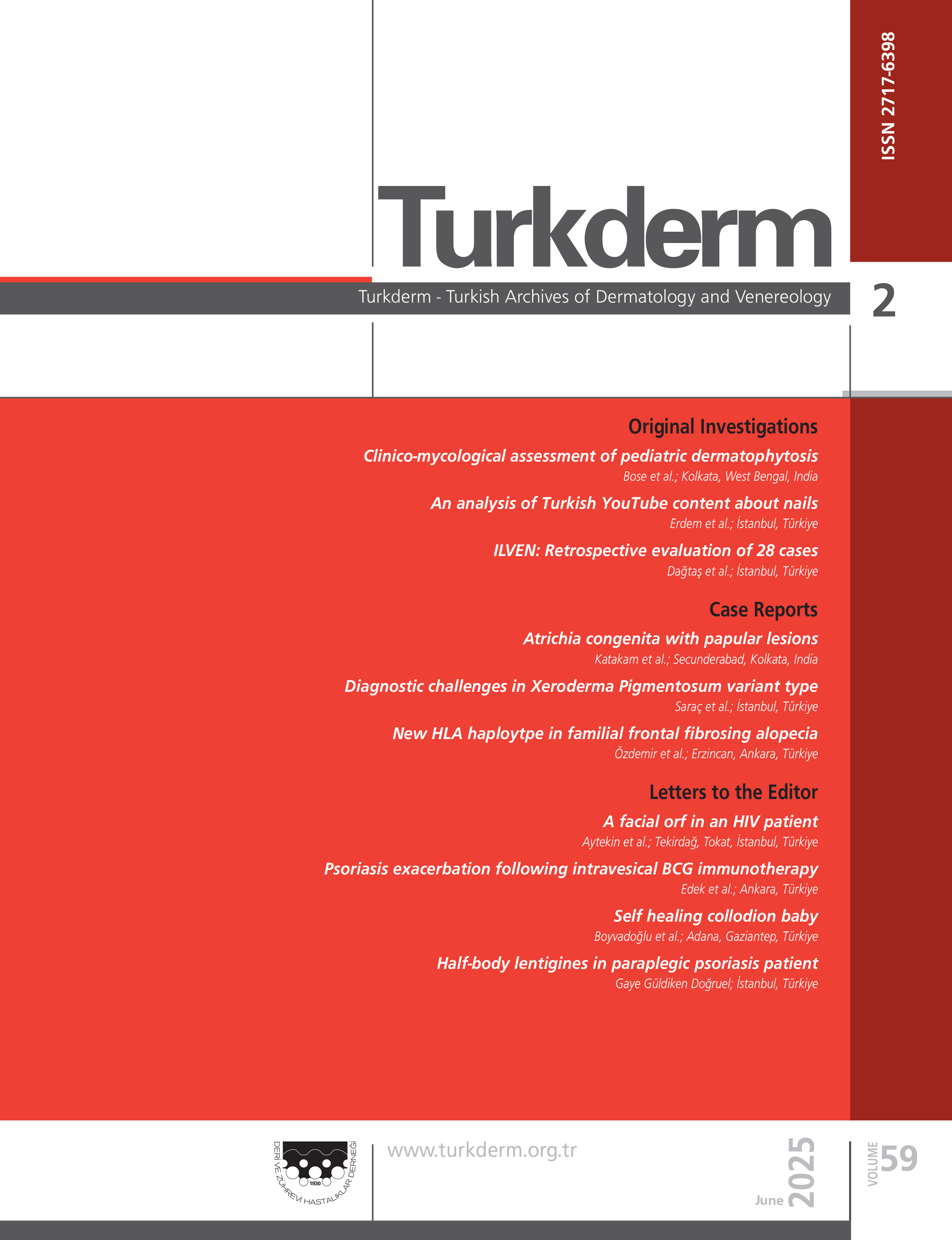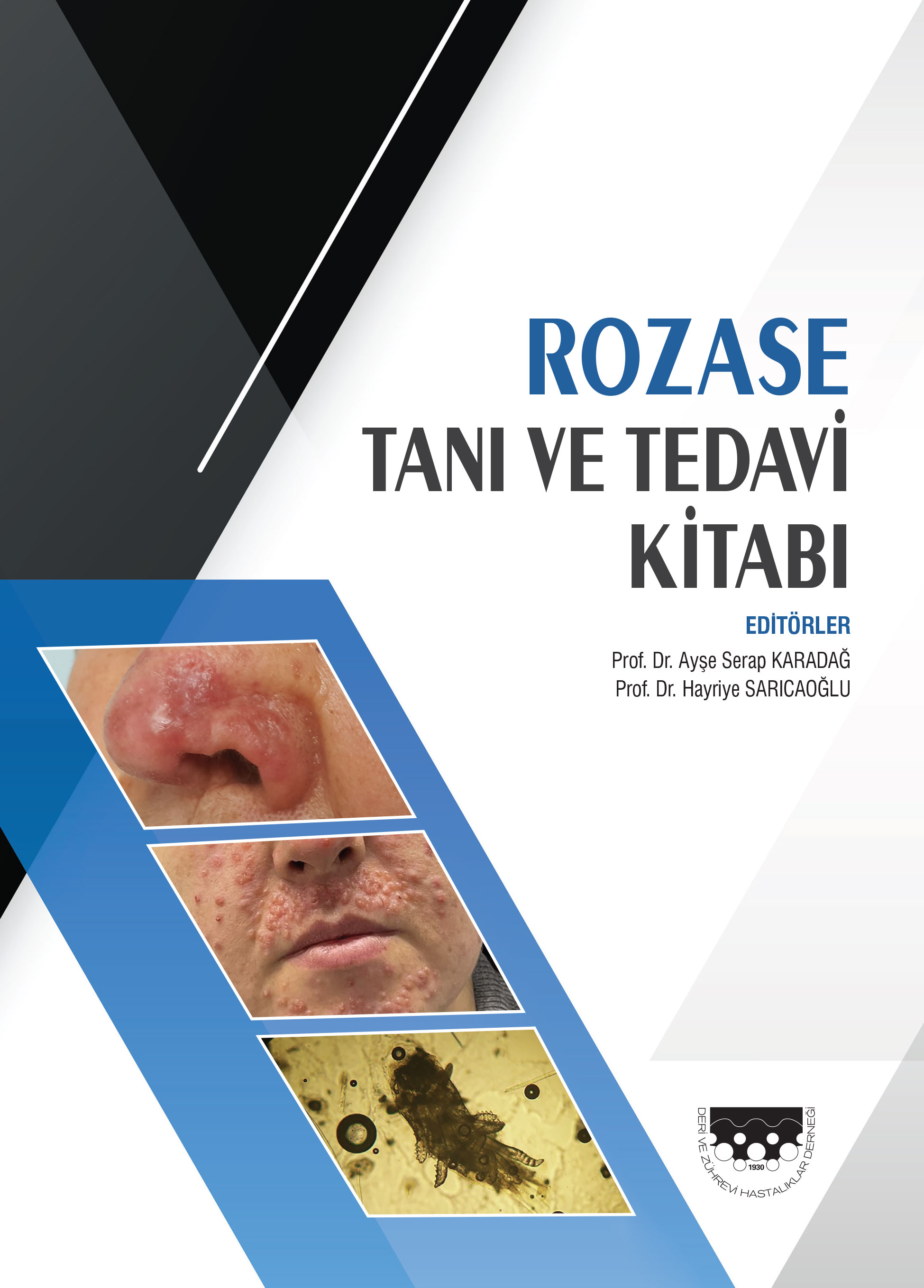Volume: 58 Issue: 2 - 2024
| 1. | Cover Pages I - V |
| ORIGINAL INVESTIGATION | |
| 2. | Content analysis of Turkish professional dermatologist accounts on Instagram, a social media platform Fatmagül Gülbaşaran, Özlem Özbağçıvan, İrem Kula, Cansu Şahin doi: 10.4274/turkderm.galenos.2023.64022 Pages 30 - 34 Background and Design: Social media has gained widespread prominence in contemporary society and has significantly impacted various critical aspects of healthcare. While Instagram was initially a platform for social interaction, it has gradually gained recognition in professional fields, including healthcare. This study aimed to analyze the content of popular professional dermatologist accounts on Instagram in Türkiye. Materials and Methods: Based on a sample of 34 dermatologist accounts with the highest number of followers, the study investigated several key parameters related to the content and account characteristics of accounts that publicly share information about dermatology. Results: Most dermatologists (29, 85.2%) were specialist physicians working in private practices. Aesthetic and cosmetic dermatology content prevailed across categories compared to medical dermatology (p<0.05). There were significant correlations between the number of followers and factors such as the total post count, the presence of cosmetic product recommendations, the sharing of procedure-related media, the use of reel videos, and the gender of the dermatologist [with a preference for female practitioners (p<0.05)]. While some accounts (17.6%) included medical treatment recommendations along with the specific drug name, 35.2% (12) included specific cosmetic product recommendations. Current literature was shared only in 3 accounts (8.8%). Most dermatologists (85.2; 29%) also shared social posts unrelated to medicine. In terms of the number, the most shared content was also paramedical (social) posts with a median value of 4 (1-8) (in the last ten posts). Conclusion: This study provides valuable insights into Turkish dermatologists online presence and content preferences on Instagram and sheds light on how healthcare professionals interact with their audience and share information. |
| 3. | Comparison of the hematological parameters of recurrent aphthous stomatitis and Behçets disease Ceylan Avcı, Sevgi Akarsu, Özlem Özbağçıvan doi: 10.4274/turkderm.galenos.2024.37999 Pages 35 - 41 Background and Design: Hematological parameters have been used as laboratory markers to evaluate the systemic inflammation in several rheumatic disease. The aim of this study is to determine the difference of hematological parameters between the patients who have been just fulfilled the Behçets disease (BD) criteria and patients with recurrent aphthous stomatitis (RAS). Materials and Methods: Twenty patients with newly diagnosed BD and 47 patients with RAS whose oral ulcerations appeared at least three times a year were enrolled in this cross-sectional study. Demographic and clinical characteristics of patients, complete blood count, C-reactive protein (CRP) and erythrocyte sedimentation rate were recorded. Results: Patients characteristics including gender, age, duration, and frequency of oral aphthous ulcerations in both study groups were comparable (p>0.05). CRP was significantly higher in newly diagnosed BD group when compared to the RAS group (p=0.001). CRP value higher than 2.7 g/dL, mean platelet volume (MPV) value higher than 7.58 fL and lymphocyte count higher than 2.85 103/μL were found to be the markers for distinguishing patients with BD from patients with RAS [odds ratio (OR): 12.76 (95% confidence interval (CI): 2.86-56.88), OR: 5.61 (95% CI: 1.11-28.42), OR: 15.24 (95% CI: 1.77-131.31), respectively]. Conclusion: The elevated CRP, MPV and lymphocyte count were associated with patients with newly diagnosed BD rather than patients with RAS. Further large prospective studies with the healthy control group are needed to confirm these findings. |
| CASE REPORT | |
| 4. | Hemorrhagic polypoid lesion on the leg - eccrine porocarcinoma: A case report Yusuf Can Edek, Betül Öğüt, Esra Adışen doi: 10.4274/turkderm.galenos.2024.56767 Pages 42 - 44 Eccrine porocarcinoma is a rarely seen cutaneous malignancy originating from the intraepidermal ductus of eccrine glands. The disease is characterized by nodular lesions primarily located in the lower extremities. The disease may arise de novo or develop from the background of eccrine poroma. Differential diagnoses of eccrine porocarcinoma include various benign and malignant skin conditions such as seborrheic keratosis, verruca, pyogenic granuloma, and squamous cell carcinoma. The histopathological analysis is essential to diagnosis, and dermoscopic imaging of lesions is significant. Eccrine differentiation, cellular pleomorphism, nuclear atypia, invasion in the histopathological examination; carcinoembryonic antigen and epithelial membrane antigen positivity in immunohistochemical study guides the diagnosis. Eccrine porocarcinoma may spread through lymphatic vessels, and therefore it is essential to perform regional lymph node examination and use appropriate imaging methods in patients. The main treatment option for eccrine porocarcinoma is wide surgical excision with clean margins, and excision can be curative in 80% of patients. |
| 5. | Delayed and recurrent jellyfish dermatitis: A case report Aysun Şikar Aktürk, Rebiay Kıran, Nilgün Sayman, Ayla Günlemez doi: 10.4274/turkderm.galenos.2024.85226 Pages 45 - 47 Jellyfish venoms cause different reactions in human skin after exposure. The most common skin findings are linear, urticarial, and painful eruptions at the areas of tentacular contact. Delayed and recurrent rashes may also occur less commonly. We report a case of a 45-year-old female patient who developed acute pruritic rash and burning as well as dizziness on the right arm while swimming off the Island of Sicily in the Mediterranean Sea. Our patient, who had an increase in lesions from time to time in the following weeks, was diagnosed with delayed and recurrent jellyfish dermatitis according to her history and clinical findings. She was treated with systemic antihistamines, systemic steroids and topical steroids. The lesions of our patient, whose lesions did not show significant improvement with systemic antihistamines, systemic steroids, or topical steroids, improved with topical tacrolimus. Since this picture is rare in our country, we found it appropriate to present our case to emphasize that jellyfish dermatitis should be kept in mind in the differential diagnosis of patients presenting with this type of skin rash and that topical tacrolimus is effective in delayed and recurrent reactions. |
| 6. | A case of concomitant hidradenitis suppurativa and psoriasis successfully treated with guselkumab in a patient with Down syndrome Simge Ünal, Tuğcan Yüksek doi: 10.4274/turkderm.galenos.2024.37801 Pages 48 - 51 In this case report, we present a 29-year-old patient with Down syndrome (DS) who manifested both psoriasis and hidradenitis suppurativa (HS) concurrently. The utilization of guselkumab, an interleukin 23 p19 subunit inhibitor that is approved for moderate to severe psoriasis vulgaris, resulted in significant improvement in symptoms for both conditions following the initial administration. The patient achieved a psoriasis area and severity index 90 response with significant amelioration of psoriatic plaques. Simultaneously, more than 50% improvement in abscess and inflammatory nodules secondary to HS was observed 4 weeks after the start of guselkumab therapy, resulting in a HiSCR score achievement. Throughout the 52-week follow-up, there were no observed exacerbations of symptoms or adverse effects. This case highlights the potential benefit of guselkumab in the simultaneous treatment of HS and psoriasis, and suggests that guselkumab is an effective and safe biologic agent of choice in individuals with DS, where the prevalence of both these diseases is increased, and treatment adherence may pose additional challenges compared to the normal population. |
| LETTER TO THE EDITOR | |
| 7. | A rare case of giant congenital melanocytic nevus associated with ipsilateral developmental dysplasia of the hip Meryem Aktaş, Deniz Yücelten, Özlem Akın Çakıcı, Evrim Karadağ Saygı doi: 10.4274/turkderm.galenos.2024.39924 Pages 52 - 53 Abstract | |























